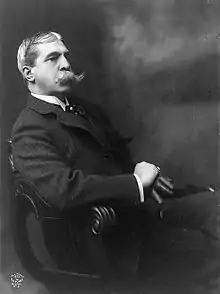Francis Hopkinson Smith
Francis Hopkinson Smith (October 23, 1838 – April 7, 1915) was a United States author, artist and engineer. He built the foundation for the Statue of Liberty, wrote many famous stories and received awards for his paintings.
Francis Hopkinson Smith | |
|---|---|
 Smith, c. 1903 | |
| Born | October 23, 1838 |
| Died | April 7, 1915 (aged 76) |
| Signature | |
 | |

Biography
Smith was born in Baltimore, Maryland, a descendant of Francis Hopkinson, one of the signers of the Declaration of Independence. He graduated from the Boys' Latin School of Maryland.
Smith became a contractor in New York City and did much work for the federal government, including the stone ice-breaker at Bridgeport, Connecticut, the jetties at the mouth of the Connecticut River, the foundation for the Bartholdi Statue of Liberty in New York Harbor, the Race Rock Lighthouse (southwest of Fishers Island, New York) and many life-saving stations. His vacations were spent sketching in the White Mountains, in Cuba and in Mexico. He also visited and sketched in Venice, Constantinople and the Netherlands.
His first popular book was Col. Carter of Cartersville (1891). His 1896 novel Tom Grogan and 1898 novel Caleb West were each the best selling book in the United States in the year of their release.
Selected bibliography
He illustrated and published numerous travelogues, including:
- Old Lines in New Black and White (1885)
- Well-Worn Roads (1886)
- A White Umbrella in Mexico (1889)
- Gondola Days (1897)
- The Venice of To-Day (1897)
His novels and short stories are especially felicitous in their portrayal of the Old South. Among them are:
- Col. Carter of Cartersville (1891), which was successfully dramatized
- A Day at La Guerre's and other Days (1892)
- A Gentleman Vagabond and Some Others (1895)(short stories)
- Tom Grogan (1896)
- Caleb West (1898)
- The Other Fellow (1899) (short story collection, including "A Kentucky Cinderella" which was adapted to film in 1917 and 1921)
- The Fortunes of Oliver Horn (1902), which has reminiscences of his artist friends
- The Under Dog (1903) (collection of 13 short stories)[1]
- Col. Carter's Christmas (1904)
- At Close Range (1905)
- The Tides of Barnegat (1906)
- The Veiled Lady (1907)
- The Romance of an Old Fashioned Gentleman (1907)
- Peter (1908)
- Forty Minutes Late and Other Stories (1909)
- Kennedy Square (1911)
- The Arm-chair at The Inn (Charles Scribner's Sons) (1912)
- In Thackeray's London: Pictures and Text (Doubleday, Page & Co.) (1913)[2]
- Felix O'Day (1915)
- Enoch Crane (1916) (completed by F. Berkeley Smith)
Selected filmography
- Kennedy Square, directed by S. Rankin Drew (1916, based on the novel Kennedy Square)
- The Tides of Barnegat, directed by Marshall Neilan (1917, based on the novel The Tides of Barnegat)
- A Kentucky Cinderella, directed by Rupert Julian (1917, based on the short story A Kentucky Cinderella)
- Felix O'Day, directed by Robert Thornby (1920, based on the novel Felix O'Day)
- Deep Waters, directed by Maurice Tourneur (1920, based on the novel Caleb West)
Notes
- (June 20, 1903). Hopkinson Smith's New Story, The New York Times
- "Review of In Thackeray's London by F. Hopkinson Smith". The Athenaeum (4495): 722. December 20, 1913.
References
- The New York Times; April 8, 1915, Thursday; F. Hopkinson Smith, Author-Artist, Dies; Engineer Who Built Foundation for the Statue of Liberty Expires at 76. Created 'Colonel Carter' His Many Famous Stories Include "Caleb West, Master Diver". Received Awards for His Paintings.
- Attribution
 This article incorporates text from a publication now in the public domain: Chisholm, Hugh, ed. (1911). "Smith, Francis Hopkinson". Encyclopædia Britannica. 25 (11th ed.). Cambridge University Press. p. 260.
This article incorporates text from a publication now in the public domain: Chisholm, Hugh, ed. (1911). "Smith, Francis Hopkinson". Encyclopædia Britannica. 25 (11th ed.). Cambridge University Press. p. 260.
External links
| Wikisource has original works written by or about: Francis Hopkinson Smith |
| Wikimedia Commons has media related to Francis Hopkinson Smith. |
- Works by Francis Hopkinson Smith at Project Gutenberg
- Works by F. Hopkinson Smith at Faded Page (Canada)
- Works by or about Francis Hopkinson Smith at Internet Archive
- Works by Francis Hopkinson Smith at LibriVox (public domain audiobooks)

- Francis Hopkinson Smith exhibition catalogs
- Artwork by Francis Hopkinson Smith